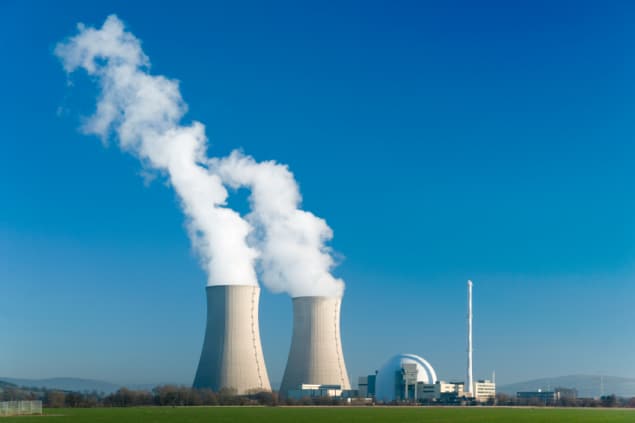Radiation damage is spotted using calorimetry technique
15 Aug 2022
Longer life New analysis technique could help extend the lives of some nuclear power plants. (Courtesy: iStock/RelaxFoto.de)
Material defects caused by radiation damage can be characterized by measuring the energy that the defects release when heated. That is the conclusion of researchers in the US and Finland, who say their new approach could lead to better techniques for quantifying the diminished performance of irradiated materials – something that could have important implications for the operation of ageing nuclear power plants.
Irradiated materials, such as those used in nuclear reactors, are damaged when the absorption of neutrons and other high-energy particles creates atomic-scale defects. This damage can, with time, degrade the material’s overall performance. However, characterizing microscopic damage can be very difficult because even cutting-edge techniques like transmission electron microscopy (TEM) cannot accurately measure the type, size, and density of defects throughout a material.
Energy release
Instead of probing defects directly, Charles Hirst at the Massachusetts Institute of Technology and colleagues looked at how irradiated materials store energy in their atomic-scale defects, and then release this energy when heated. The key to their technique is that this release occurs once a certain energy barrier is reached – a barrier that is specific to the nature of the defect.
To observe this process, they used a technique called differential scanning calorimetry (DSC), which measures the difference between the amount of heat required to raise the temperature of a sample, and a reference material with a well-defined heat capacity.
In this case, the sample was a small titanium nut, irradiated for 73 days, which simulated the radiation it would experience in real nuclear reactor. As a reference, the team used an identical nut that had not been irradiated. In their experiment, they gradually heated the sample and reference from room temperature to 600°C, at a rate of 50°C per minute.READ MORE

The study revealed that between 300–600°C, excess energy was released from the irradiated nut in two distinct stages, indicating that defects relax at these temperatures through two different mechanisms. Hirst’s team then used molecular dynamics simulations to understand each of these mechanisms.
With TEM, these defects could only be studied at far lower temperatures, therefore the behaviour of defects in the higher temperature range could only be extrapolated by the team. So far, this has allowed them to identify one energy release process. Based on this result, Hirst and colleagues predict that DSC has the potential to uncover many new mechanisms for energy release in other materials, revealing defects that have so far remained hidden to other techniques.
Their approach could be particularly useful for inspecting nuclear reactors. By extracting small samples from reactors, operators could use DSC to better quantify the extent of how a component has degraded from radiation exposure. This could help reactor operators to make more informed decisions about whether components are safe to continue operating. In turn, this could extend the lifetimes of existing nuclear plants – even those considered to be reaching the end of their lifetimes – for decades to come.
The research is described in Science Advances.
Sam Jarman is a science writer based in the UK.
FROM PHYSICSWORLD.COM 18/8/2022

Δεν υπάρχουν σχόλια:
Δημοσίευση σχολίου